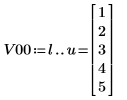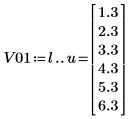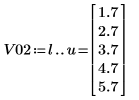Example: Summation and Product Operators
Use the summation and product operators to add or multiply a sequence of terms. You can either cast the elements to be summed or multiplied as vectors, or you can implicitly specify the elements in the range of the operator itself.
Using the Operators to Calculate the Sum or Product of a Vector or Function
1. Define a range sequence.
 |
 |
 |
2. Use the summation and product operators to find the sum and product of the elements of vector v.
 |
 |
 |
3. Define a function and use the operators to find the sum and product of its elements.
 |
||
 |
 |
|
 |
 |
The product operator returns 0 because the first element of the vector is 0. Adjust the lower and upper limits of the range sequence and reapply the product operator.
 |
 |
 |
 |
 |
Using Different Lower and Upper Range Limit Values
1. Set the lower limit=integer, upper limit=integer.
 |
 |
 |
The last element of the vector equals m+largest multiple of the step size and its value must be less than or equal to the upper limit of the range sequence.

Verify that the next calculated element is larger than n and thus not added to the vector:

Calculate the sum and product.
 |  |  |
 |  |
2. Set lower limit=real and upper limit=integer.
 |  |  |
 |
Calculate the sum and product.
 |  |  |
 |  |
3. Set lower limit=real and upper limit=real.
 |  |  |

Calculate the sum and product.
 |  |  |
 |  |
Perform Combinations of Summation and Product Calculations
1. Calculate summation of summation and summation of product by cascading the two operators.
 |  |
2. Calculate product of summation and product of product by cascading the two operators.
 |  |